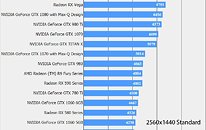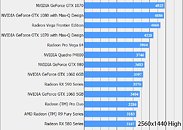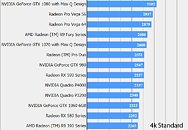Tuesday, October 30th 2018

AMD Radeon RX 590 Built on 12nm FinFET Process, Benchmarked in Final Fantasy XV
Thanks to some photographs by Andreas Schilling, of HardwareLuxx, it is now confirmed that AMD's Radeon RX 590 will make use of the 12 nm FinFET process. The change from 14 nm to 12 nm FinFET for the RX 590 brings with it the possibility of both higher clock speeds and better power efficiency. That said, considering it is based on the same Polaris architecture used in the Radeon RX 580 and 570, it remains to be seen how it will impact AMDs pricing in regards to the product stack. Will there be a price drop to compensate, or will the RX 590 be more expensive? Since AMD has already made things confusing enough with its cut down 2048SP version of RX 580 in China, anything goes at this point.Thanks to the Final Fantasy XV Benchmark being updated with results for the RX 590, we at least have an idea as to the performance on offer. In the 2560x1440 resolution tests, performance has improved by roughly 10% compared to the RX 580. Looking at the 3840x2160 resolution results shows a performance improvement of roughly 10 to 15%. This uplift in performance allows the RX 590 to put some serious pressure on NVIDIA's GeForce GTX 1060 6 GB. Keep in mind that while the RX 580 was always close, AMD's latest Polaris offering eliminates the gap and is far more competitive in a title that has always favored its competition, at least when it comes to comparing reference cards.When manual overclocking is taken into account, AMD's RX 580 can typically see a performance increase of around 5 to 10%. While this is speculation, in theory, it would put it on par or very near the RX 590 in terms of performance. However, no overclock is guaranteed so keeping that in mind, the move to the 12 nm FinFET process delivers a guaranteed performance boost with the possibility of further overclocking headroom. This should allow the RX 590 to further increase its performance advantage over the RX 580 and 570. Only time will tell how things shake out, but at the very least users can expect the AMD Radeon RX 590 to deliver on average 10% more performance over the current crop of RX 580 graphics cards.
Sources:
Twitter, FFXV Benchmark, via Videocardz








70 Comments on AMD Radeon RX 590 Built on 12nm FinFET Process, Benchmarked in Final Fantasy XV
So no reconfiguring the arch. This takes confusion out of the cards unlike greens crippled versions.
But used a used 56 can be had for a pretty good price now.
I don't regret getting a 1070, but I have a Freesync monitor and I can't use what is already there, it's just not enabled. One of the cons, I had to look over which still haunt me. The state of the market had forced me to pick what was best at the time. Now I wish I had a 56 because I cannot find benchmarks with newer drivers for some older titles which typically favored Pascal, but OC'ing only bring single digit improvements. Maybe Polaris/Vega is overall better right now, it's been ages since launch.
I wouldn't mind a side-grade, but only if I knew for sure I was going to happy with the switch, I got burned with the R9 300 series before. With new Vega cards being rumored, most should probably hold-off on an upgrade until RTG shows what they have next.
Most gains when oc'ing was actually increasing the memory timings, and not clockspeeds. I.e straps of 1750Mhz applied on 2000Mhz and look for additional headroom when overclocking memory. This combined would give a nice increase but proberly not near close the 1070. The RX580 is a good mid range card but a Vega 56 is a better choice anyway.
Also interested to see how much performance/W improved on 12nm.
It's techically not a rebrand, but it very much feels that way, this is 480/580 with just a very minor die shrink. As for power savings, do you really think they can bump clocks and save a noticeable amounts of power at the same time going from 14 to 12 ?
Lets await benches and OC results. We know that AMD already pushes the chips pretty much beyond. There is not much high OC headroom without giving into huge power requirements. (i.e Vega 56 on 400Watts / 1700Mhz core)
If they chose to raise the clocks, you can't also expect lower power consumption. It will be the same of RX580.
Expect the same price of the RX580 (or a bit higher). They have no reasons to lower it (it's already lower than GTX1060's one).
Remaining RX580s will be discounted, of course. Good luck in finding one (they are waiting for supplies to end before introducing this RX590).
And that's all for 2018's AMD VGAs.